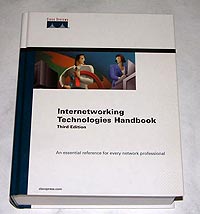Internetworking Technologies Handbook
Even the best of us sometimes
need to look up techie info in a book... Now there is nothing wrong with
admitting that, but if you pull out a lack luster resource book you aren't going
to learn much are you? As they say, "good staff need excellent resources", and
Cisco's Internetworking Technology Handbook may just be the one block of paper
you need for all things networking. Roll up your sleeve and get your Cat 5
crimpers ready because this book isn't light reading. Heck it isn't even
entertaining, but it does fill in the technical blanks better than any top 10
paper back ever could.
With extra strength coffees in hand we took this
massive 1077 page book in hand began the process of skimming through it for some
answers to some networking questions we've had for a while, and also some we
already know the answers to - to gage the level of information the book is
putting across.
Coffee, Ethernets and everything you ever
wanted to know about cable.
Well almost. The book covered the section on
cabling with fairly good detail. The differences in UTP cable were explained
down to the resistance of the wire, but unfortunately stopped short of even a
brief explanation of 468A and 468B wiring schematics - or any schematics for
that matter. While the theory behind the assignment of MAC addresses is
riveting I was kind of disappointed that such a basic bit of info as wiring
cable was omitted. On the plus side, networking technologies from 10 Base T to
1000Base-X were covered, along with some fundamental network architecture
discussions.
Would you like a network cache with your
large SOHO blend?
The book makes and interesting discussions on
network caching - something that can be a godsend if properly set up on a high
traffic website. Ultimately though, and as you might expect the focus is on Cisco
branded solutions to online caching. The treatment of the information is on the
intermediate level, and stays on the holistic level. For example, if you are
considering setting up network caching for your superfabulous techie site, and
are confused about Overload Bypass and Dynamic Client Bypass, you can turn to
page 805 and read a short paragraph about each technique. Ultimately the
treatment is more descriptive than a hard core handbook on how to go about
achieving the solutions, but the information is exceptionally clear and well
written in plan language.
To be clear though, this is not a "dummies" book.
Internetworking Technologies assumes you are at least partially familiar with
many basic computing concepts. Those who find themselves reading this book will
be those of us struggling to define exactly what ADSL is for example. Granted we
all know it means internet over the phone lines, but who of us can really stand
up in the pub and say "ADSL depends on advanced digital signal processing and
creative algorithms to squeeze so much information through twisted-pair
telephone lines?" Well, now you can at least...
The following chapters are
included in
Cisco Press's Internetworking
Technology Handbook;
Part 1 - Introduction
to Networking
- Internetworking
Basics
- Introduction to LAN
protocols
- Introduction to WAN
technologies
- Bridging and Switching
Basics
- Routing Basics
- Network Management
Basics
Part 2 -
LAN Protocols
- Ethernet
technologies
- Fiber Distributed Data
Interface
- Token Ring/IEEE
802.5
Part 3 - WAN
Protocols
- Frame Relay
- high-Speed Serial Interface
- Integrated Services Digital Network
- Point-to-Point Protocol
- Switched
Multimegabit Data Service
- Dialup Technology
- Synchronous Data Link control and Derivatives
- X.25
- Virtual Private Networks
Part 4 - Multiservice Access
Technologies
- Voice/Data Integration
Technologies
- Wireless
Technologies
- Digital
Subscriber
Line
- Cable
Access
Technologies
Part 5 - Bridging and
Switching
- Transparent
Bridging
- Mixed-Media
Bridging
- Source-route
Bridging
- LAN
Switching and
VLAN's
- Asynchronous Transfer Mode
Switching
- MPLS/Tag
Switching
- Data-Link
Switching
Part 6 - Network
Protocols
- Open
System Interconnection
Protocols
- Internet
Protocols
-
IPv6
- Xerox
Network
Systems
- NetWare
Proto
cols
-
AppleTalk
- Banyan
VINES
- IBM
Systems Network Architecture
protocols
-
DECnet
Part 7 - Routing
Protocols
- Border
Gateway
Protocol
- Enhanced IGRP
- IBM Systems Network
Architecture Routing
- Interior Gateway Routing
Protocol
- Internet Protocol
Multicast
- NetWare Link-Services
Protocol
- Open Shortest Path
First
- Routing Information
Protocol
- Resources Reservation
Protocol
- Quality of Service
networking
- Simple
Multicast Routing Protocol
Part 8 - Internet Access
Technologies
- Security
Technologies
- Directory-Enabled
networking
- Network Caching
Technologies
Part 9 - Network
Management
- IBM Network
Management
- Remote
Monitoring
- Simple Network Management
Protocol

